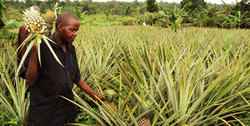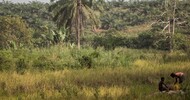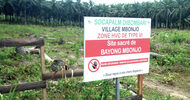
Nobody seems to be quite sure just how much land the fruit-growing and processing multinational owns in the region (File photo)
Multinationals must prepare to cede some land to the very poor
In Summary
- It is estimated that Del Monte owns 22,000 acres while others say the land is actually more than 45,000 acres.
- However, the matter should be laid to rest when a survey ordered by the National Land Commission identifies just how much land is being utilised.
- Whatever the case, it is doubtful the company can continue owning so much land in perpetuity.
By MAGESHA NGWIRI
As young secondary school students in Thika town, my friends and I were always mesmerised by the rows upon rows of ripening pineapples in the vast plantation just across the valley. This mouth-watering vista was, of course, out of reach to anyone but the workers in the then Kenya Canners Ltd, the vicious security guards and their murderous dogs who ran the place, and so we contented ourselves with stealing sugar-cane growing in the valley below, which I now suspect must have been fertilised with sludge from the town’s sewerage works.
999-YEAR LEASES
Today, Kenya Canners is known as Del Monte Ltd, but little else has changed; the pineapple plantation straddles kilometre upon kilometre of fertile well-watered land that is at once a delight to the eye and a subject of covetous debate in Murang’a and Kiambu counties. Nobody seems to be quite sure just how much land the fruit-growing and processing multinational owns in that region, but everyone agrees it is way too much in an area that has too little land and too many people.
It is estimated that Del Monte owns 22,000 acres while others say the land is actually more than 45,000 acres. However, the matter should be laid to rest when a survey ordered by the National Land Commission identifies just how much land is being utilised so that the rest can be surrendered to the respective counties. Whatever the case, it is doubtful the company can continue owning so much land in perpetuity when the surrounding areas are bursting at the seams with a burgeoning, landless population.
This whole issue of historical land injustices and how they should be rectified erupted a few years ago when it was realised that there was a chance some multinational companies could be forced to cede land in Murang’a, Kiambu, Kericho, Nandi, Laikipia, Taita Taveta and Machakos counties. The foreigners were granted the land under 999-year leases by the colonial governments, ostensibly because it was unoccupied. However, with the enactment of the 2010 Constitution, the leases were reduced to 99 years — retroactively — which meant they would expire from this year.
INSECURITY
On the whole, the vast swathes of land were not acquired legally. In fact, such acquisitions were coloured by violence and forcible displacement. Although the atrocities may be difficult to prove in court today, it is clear they took place. Indeed, they are precisely the reason why our forefathers took to the bush, mainly in the central regions as well as areas previously occupied by the Nandi, Kipsigis, and Ogieks in Rift Valley.
But the leadership in Murang’a and Kiambu seem to have settled on a different accommodation. They are, seemingly, looking at the issue in terms of high unemployment, rampant insecurity, substance abuse among youth, as well as a high incidence of slums. In connection with the lease that has ostensibly been agreed upon by Del Monte and the Kiambu County Government, a number of questions arise: What is the precise duration of the current lease?
What is the exact area occupied by Del Monte and is it similar to what is provided for in the lease? What other conditions are attached to the current lease? These negotiations seem to have been carried out without consultations, which is why there is a dearth of pertinent information. It is not quite clear whether this renewal is legally binding, and it would not be surprising if the matter was taken to court.
BLOODY CHAOS
Experts opine that there are three options available. The first one is to renew all the land claimed by Del Monte. This is the easiest, or laziest, way forward because there will not be any court action, and some people will demand and receive their cut for making the work easy. The downside, however, is that the dreams of poor and landless, who for the last 40 years have been nursing hopes of getting a piece of the Del Monte land, will be shattered once they realise they will have to wait for another 100 years.
The second option is to renew the lease for only part of the land under use by Del Monte. For instance, out of the 22,000 acres the company claims, only 10,000 are under pineapple; the rest could be used to settle the landless. As long as the admirable agricultural infrastructure built by the company remains in place, there is no reason why they cannot engage in productive activities as outgrowers supplying the company. This will assist them to eventually own land on which to build shelter for their families.
The third, and probably most undesirable, option is the total takeover of all the land except where the company’s processing factory is situated. This Zimbabwe-type land-grab has few redeeming features. The problem with it is that ownership will merely change hands from foreign owners to local tycoons. However, with careful planning, this option may eventually become the only one available. In the past, Kenyans fought the colonialists over land, and given no other choice, their descendants may do the same thing, a recipe for bloody chaos and which may precipitate investor flight.
Mr Ngwiri is a consultant editor; [email protected]













